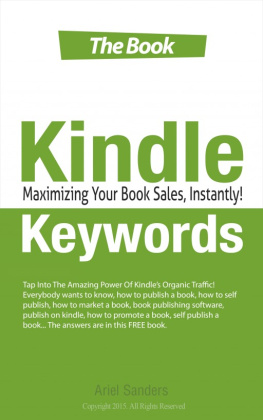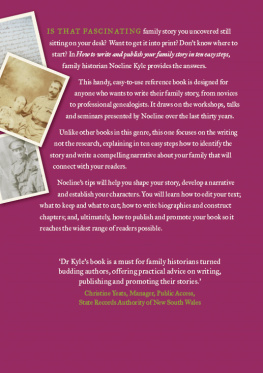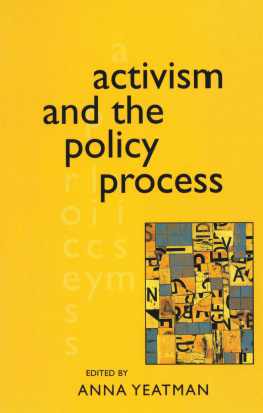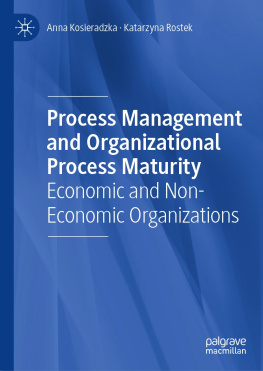b, know about the
O/, self-publishing
L//\
Sr* process
% \ %
o

S~\
Some related titles from HowTo Books
Awaken the Writer Within
Release your creativity and find your true writer's voice
'Your true writer's voice is unlikely to inhabit the realms of logic... this book takes you on a journey into the subconscious to help you find that voice - and use it. The results can be both amazing and satisfying.' - Writer's Own
Writers' Guide to Copyright and Law
Learn what rights you have as a writer and how to enjoy them; what obligations you have and how to comply with them
'Clear, no-nonsense style ... no jargon or waffle - just sound common sense advice.' - Alison Chisholm, BBC Radio
Write Your Life Story
How to record and present your memories for friends and family to enjoy
'Making a professional job of your autobiography is a very worthwhile project and Write Your Life Story will help you make a polished job of it.' Writing Magazine
Send for a free copy of the latest catalogue to: How To Books Spring Hill House, Spring Hill Road Begbroke, Oxford, 0X5 1Rx, United Kingdom email:
/\
* 1%
Everything you need to know about the self-publishing process

Anna Crosbie
howtobooks
Published by How To Content,
A division of How To Books Ltd,
Spring Hill House, Spring Hill Road,
Begbroke, Oxford 0X5 1RX. United Kingdom.
Tel: (01865) 375794. Fax: (01865) 379162. email:
All rights reserved. No part of this work may be reproduced or stored in an information retrieval system (other than for purposes of review) without the express permission of the publisher in writing.
The right of Anna Crosbie to be identified as the author of this work has been asserted by her in accordance with the Copyright, Designs and Patents Act 1988.
Copyright 2006 Anna Crosbie
First published in paperback 2006 First published in electronic form 2007
ISBN: 978 1 84803 047 3
Produced for How To Books by Deer Park Productions, Tavistock, Devon, UK Typeset by PDQ Typesetting, Newcastle-under-Lyme, Staffs, UK Cover Design by Baseline Arts Ltd, Oxford, UK
NOTE: The material contained in this book is set out in good faith for general guidance and no liability can be accepted for loss or expense incurred as a result of relying in particular circumstances on statements made in the book. The laws and regulations are complex and liable to change, and readers should check the current position with the relevant authorities before making personal arrangements.
Contents
With thanks to my agent Peter Buckman for giving me confidence and determination, and to my husband Tony, for putting up with it.
This page intentionally left blank
Those of us who are passionate about the books we write dream of seeing our book in print. Some of us dream of seeing it on a bookshelf in a book store, or even mentioned in the bestsellers list. Others of us dream of just holding it in our hands and witnessing the evolution of our tirelessly written manuscript into a proper book format.
Having experienced the joys and frustrations of having my books published by mainstream publishers, I decided in 2004 to publish my next two books myself: one non-fiction book and one novel. Several months later I was able to reflect on the joys and frustrations of publishing my own books. In a nutshell, it is not easy, nor simple, nor a guaranteed means of making vast profits. However, publishing your own book is a rewarding experience, and if you approach it with the necessary degree of business planning, it can be a financially rewarding experience also.
In this book you will find the information you need to inform your self-publishing decisions.
What do you want to achieve?
What are you willing and able to invest?
What do you need to know about the publishing industry before you start?
And, of course, budgeting, marketing, and selling.
Writing your book is only the beginning: the hard work comes next. In the course of researching the case studies included in
Chapter 10, I spoke to many people who have published their own books. All of them reiterated this point in their own way: publishing your book takes ongoing commitment. In the case studies you will see the hugely different approaches people have taken to self-publishing. Some were delighted to print just a small number of copies for family and friends. Others viewed their selfpublishing as a long-term business investment.
I have written this book to guide you through the process of publishing your own book. I hope it not only informs you, but also inspires you to give it a try.
Happy publishing!
What is Self-publishing?
Self-publishing is the process of turning something you have written into a printed book, which you in turn market, sell and distribute. You are in complete control of all stages of the publishing process. You make all the decisions, you reap all the rewards - and you take all the risks.
Self-publishing contrasts with the traditional process of getting a book published, whereby authors send their written work, in manuscript form, to an established publisher. If a publisher agrees to publish the book, the publisher will organise the printing, marketing, sales and distribution of the book, and pay the author a royalty in return.
Self-publishing should not be confused with vanity publishing. Vanity publishers will arrange the publication of your book and pass on the full cost of publication directly to you, the author. You are often asked to pay upfront. You will be promised royalties, but be aware that once the vanity publisher has received your payment for their production costs, they have little financial incentive to bother selling your book.
Vanity publishers have been the subject of various investigations, reports of the BBCs Watchdog programme, and even the subject of a House of Lords debate during which it was suggested that the law should be changed to stop rogue operators in the publishing industry. Proceed with caution!
Technically, a self-published book should have the authors chosen publishing name on the books copyright page. The books ISBN number should be registered to you, the author, under that same publishing name. On the copyright page of your book you will also incorporate a standard statement about rights:
All rights are reserved. No part of this book can be stored on a retrieval system or transmitted in any form or by whatever means without the prior permission in writing from the publisher.
All rights are reserved by the publisher. When the publisher is you, operating under your chosen publishing name, you have retained all rights to your book. If the publisher is not you, you have not retained all rights to your book, and your book is not selfpublished (even though you may have paid a third party up front for the production and publishing costs).
There has been much debate within the publishing industry about the growth of self-publishing in recent years:
Some people view self-publishing as the new vanity publishing.
Others view self-publishing as the new slush-pile of the publishing industry, by which they mean authors who previously remained in the slush-pile whilst waiting to be noticed by the commissioning editors of the large publishing houses, are now self-publishing their books whilst waiting to be noticed by the commissioning editors of large publishing houses. Different opinions abound as to whether this is a good or bad thing.
Next page










